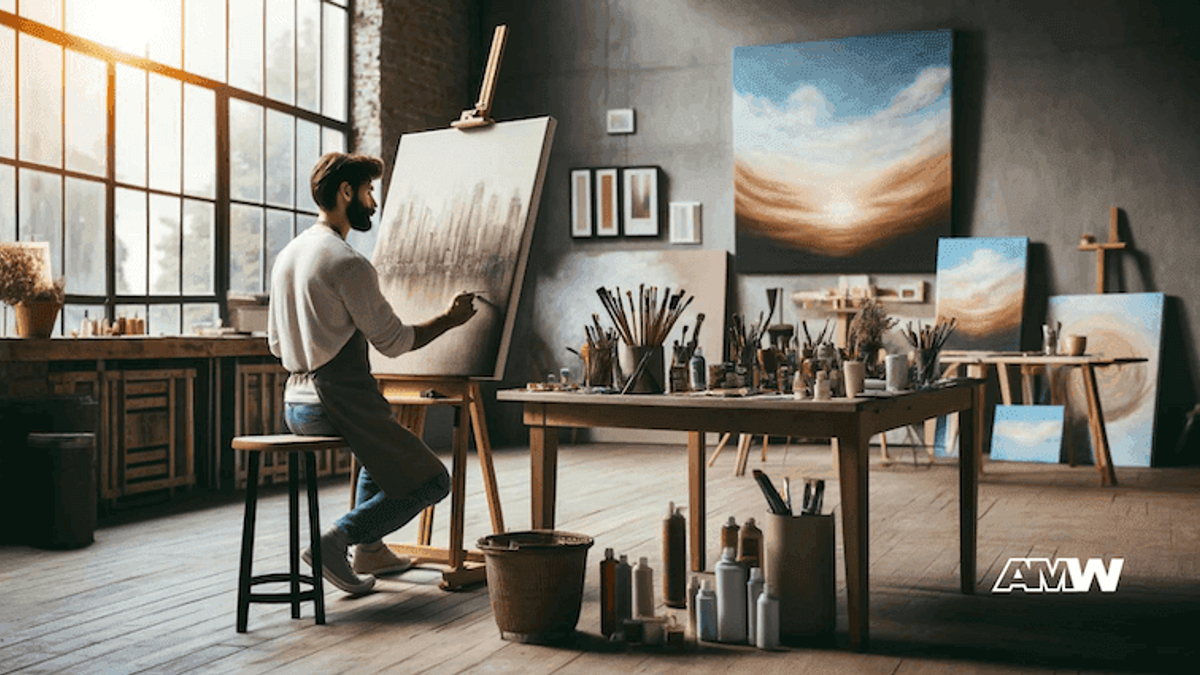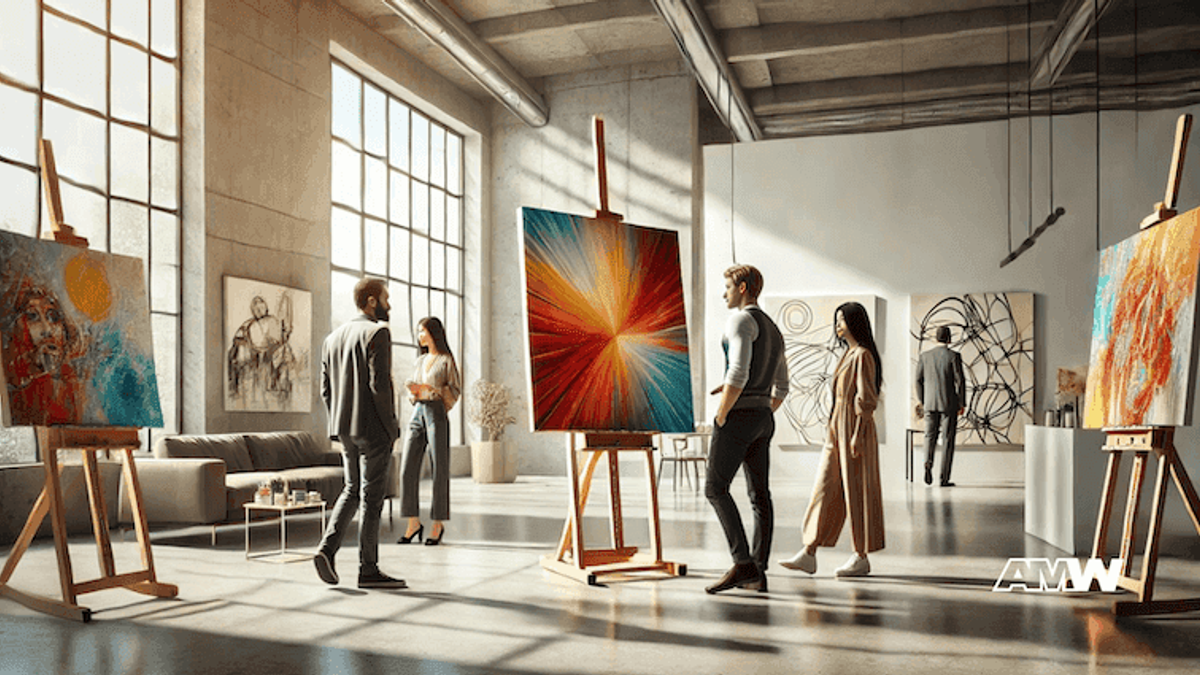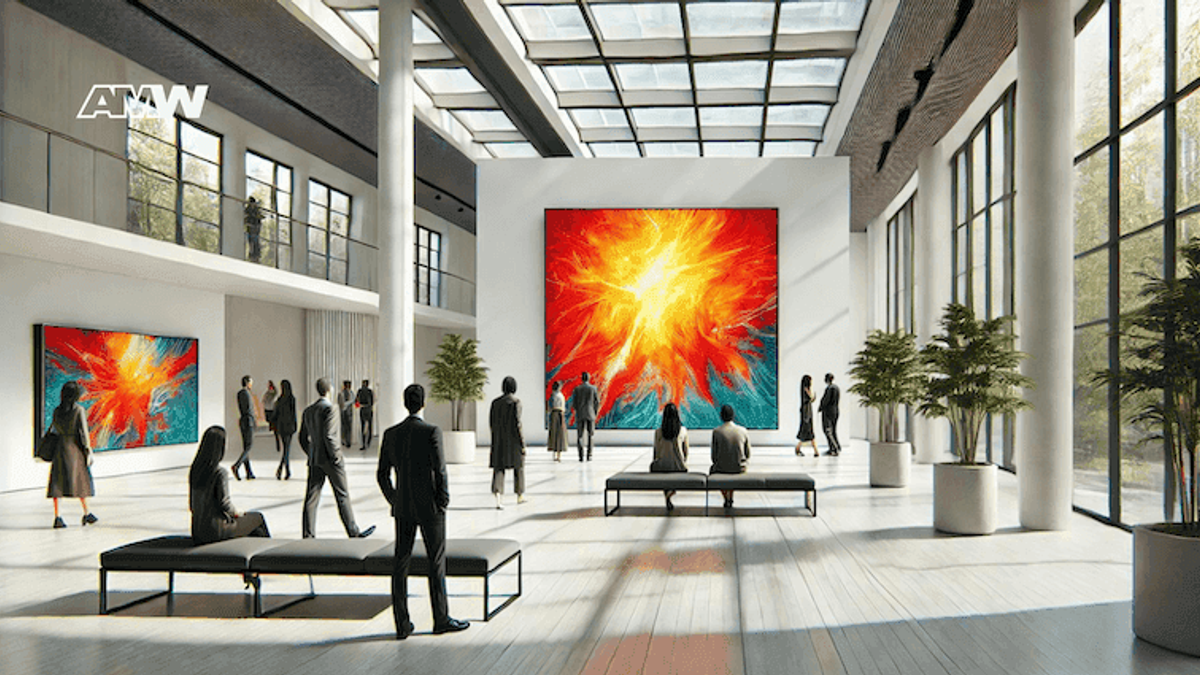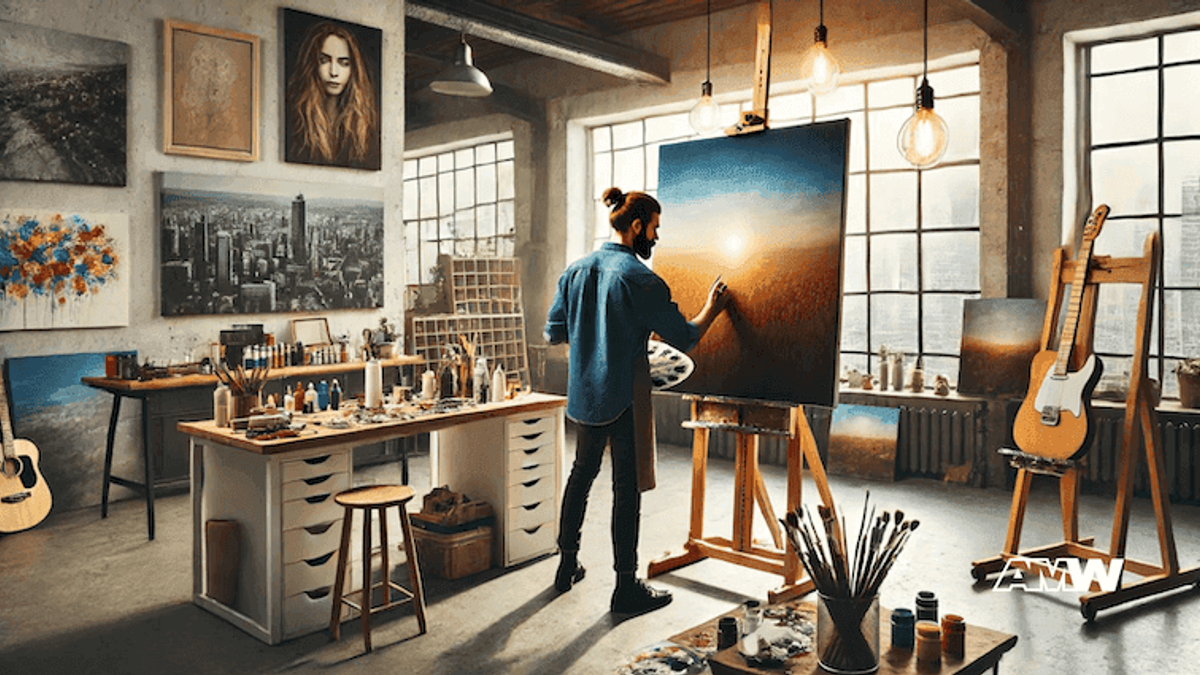The Art of Marketing Art

Art marketing is the strategies and tactics used to promote and sell art. It's building a brand, creating content and using social media to reach a wider audience. Art marketing isn't just about selling art; it's about creating an emotional connection between the artist and the potential buyer.
Quick Summary
Art marketing involves strategies to promote and sell artworks, creating an emotional bond between artists and buyers. Today, a solid marketing plan is essential for artists, enhancing visibility and sales potential. With online platforms like social media, artists can showcase their work globally, democratizing art sales. Understanding one’s audience and developing a unique artistic identity are vital. Engaging content, strong personal branding, and effective networking further enhance marketin
Why Marketing is Important in the Art World Today
Marketing is essential for an art career. Good art marketing can increase art sales and exposure for artists exponentially. Without a marketing plan, even the most talented independent artist will struggle to get noticed in a crowded art world. Marketing your art helps to build a brand and make a lasting impression on art lovers and collectors.
Ready to Grow Your Business?
Get a custom strategy tailored to your goals.
Historical Context and Evolution of Art Marketing
In the past, art marketing was mainly gallery representation and word of mouth. Artists relied on galleries to show and sell their work and patrons and collectors to promote the artist. With the digital age, art marketing has changed dramatically. Today, artists can use online portfolios, social media, and art websites to reach a global audience.
This has democratized the art market, and many artists can promote and sell their work independently.
The Market

Who is Your Audience
Understanding your audience is key to successful art marketing. Art buyers are from various demographics and psychographics. Age group, income level, education, and lifestyle influence their buying decisions.
For example, younger art fans may like contemporary and digital art, while older collectors may like classical pieces.
Identifying and targeting a specific art niche can supercharge your marketing. Niche markets make you focus your resources on a particular segment of art lovers who share common interests.
Whether it's abstract art, photography, or sculptures, targeting a niche market helps you create art that resonates with a specific group of people and increases the chances of art sales.
How to Research Your Target Audience:
To market your art effectively, you need to know what your target audience likes and dislikes. Research methods such as surveys, interviews, and data from social media can give you valuable insights. Joining art communities and participating in art shows can also help you understand what potential buyers are looking for.
Following successful artists and studying their marketing can give you practical tips.
Having a personal website is a great way to show your work and attract a wider audience. Using email marketing software to keep in touch with art fans and collectors and writing for art blogs can drive traffic to your site.
Having a strong artist statement and business logo can help you build a brand. Collaborating with other artists and guest posting on popular art blogs can increase your visibility.
High quality images of your art, compelling artist statements and informative blog posts can generate interest and connect with your audience on a deeper level.
Whether you're showing art in a physical show or selling art online a marketing plan is crucial for success in the art business.
Building Your Artist Brand

Your Unique Artistic Identity
In the art world, it's highly competitive. Building a strong personal brand is key to success. A personal brand creates a lasting impression on potential buyers and art collectors.
It sets you apart from other artists and makes your work recognizable and memorable. Art marketing revolves around a defined personal brand that communicates your unique artistic identity.
How to Develop a Style that's Consistent and Recognizable
- Define Your Artistic View: Start by knowing what inspires you and what themes you want to explore in your art. This will help you create art that's true to your vision.
- Consistency is King: Make sure your work has a consistent style, whether it's through color palette, technique, or subject matter. Consistency is key to your brand.
- Get Feedback: Engage with other artists and art lovers in the art community to get feedback on your work. This will give you insight into what parts of your art resonate with your audience.
- Document Your Process: Share your process on social media or art blogs to connect with your audience. It adds a personal touch to your brand.
How to Stand Out from Other Artists In the art world, it's busy; you need to stand out. Here's how:
- Unique Style: Create a unique style that sets you apart. This could be through unusual techniques, different subject matter, or innovative materials.
- Your Story: Your personal story and what drives you to create art can be a powerful differentiator. Share this through your personal website, artist statement, and social media to connect with your audience on a deeper level.
- Engaging Content: Create content that shows your personality and artistic journey. Use marketing materials like videos, blog posts, and behind-the-scenes content to engage with your audience.
Writing Your Artist Statement and Bio
A good artist statement is part of your marketing plan. It provides context for your work, explaining the ideas, themes, and processes behind your art.
A well-written artist statement can generate interest and make a strong first impression on art collectors, gallery owners, and potential buyers.
Tips for Writing a Great Artist Bio
- Keep it Short and Sweet: Your bio should be brief and informative, with essential info about your background, education, and artistic achievements.
- Highlight Your Achievements: Mention notable exhibitions, awards, and gallery representations. This adds credibility to your profile.
- Personalise: Include personal details that humanize you and make your story relatable. Share what drives you and the journey that led you to become an artist.
Artist Statement and Bio Examples
- Artist Statement: "I explore the relationship between the ephemeral nature of human emotions and the permanence of art. Through color and texture, I capture moments of happiness, sadness, and contemplation and invite the viewer to reflect on their own experiences."
- Artist Bio: "Firstname Lastname is a contemporary artist based in New York. With a fine arts degree, her work has been exhibited at many shows. Her unique approach to color and form has a loyal following among art collectors and art lovers. She continues to experiment with her art practice, drawing from everyday life and the natural world."
Having a strong brand through a unique artistic identity, good artist statements and bios is key to marketing your art.
Using online portfolios, social media, and other digital platforms can multiply your reach to a bigger audience and succeed in the art business.
Marketing Art

Online Marketing
Using Social Media Platforms (Instagram, Facebook, X)
Social media is a powerful tool for marketing art. Platforms like Instagram, Facebook, and X allow artists to showcase their work, engage with art lovers, and reach a global audience.
Posting regular high-quality images of your art, sharing behind the scenes-of your creative process, and interacting with your followers can supercharge your art marketing. Creating business accounts on these platforms helps you to have a professional presence and tools for better audience engagement and analytics.
Having a Professional Website
Having a professional personal website is essential for an art career. Your site is your online portfolio, showcasing your best work, artist statement, and bio. It should be easy to use, look good, and be SEO-optimised to attract more visitors.
Having a blog on your site where you share updates, thoughts on the art world, and behind-the-scenes of your art practice can engage your audience further. Using email marketing to send newsletters can keep your art fans informed about new work, upcoming shows, and special offers.
Using Online Galleries and Marketplaces
Online galleries and marketplaces are great places to sell art. These websites have a built-in audience of art collectors and art lovers, so it's an easier way to reach potential customers. Listing your work on these platforms can multiply your exposure and art sales.
Remember to update your listings regularly and optimize them with good descriptions and tags to increase visibility.
Offline Marketing
Art fairs and exhibitions are traditional but effective ways of marketing your art. Participating allows you to showcase your work to a bigger audience, network with other artists, and get feedback. It's also a chance for direct sales and building relationships with art collectors and galleries. A well-presented booth or display can leave a lasting impression on visitors and generate interest in your work.
Building relationships with art galleries and art dealers are part of offline art marketing. Galleries can give you exposure and credibility to your work. Networking with gallery owners and art dealers can lead to gallery representation, which can supercharge your art career. Attend gallery openings, art shows, and industry events to connect with these people and stay up to date with the latest trends and opportunities in the art world.
Collaborating with other artists and art institutions can open up new channels for marketing your art. Joint exhibitions, collaborative projects and partnerships with art schools or museums can increase your visibility and credibility. These collaborations can also lead to guest posts on popular art blogs and features in art magazines and more exposure to your work.
Content Marketing
Storytelling is a powerful tool in art marketing. Sharing the story behind your work, your inspirations, and your creative process can create a deeper connection with your audience. Storytelling makes your art more relatable and memorable and gets art lovers to become fans and collectors.
Content That Resonates with Your Audience
Creating content that resonates is key to successful art marketing. This includes blogs, videos, and social media updates that shows your work and artistic journey. Content that entertains or inspires your audience will generate more interest and engagement. Use quality images and videos to show your art and process, and consider sharing behind the scenes to humanize your brand.
Ready to Grow Your Business?
Get a custom strategy tailored to your goals.
Regularly updating your art blog with new posts about your latest work, exhibitions, and thoughts on the art world will keep your audience engaged. Videos are great for showing your process and giving virtual tours of your studio. Newsletters sent through email marketing software will keep your art fans updated on new releases, upcoming events, and special offers. These tools will help you build a relationship with your audience and keep them informed and engaged with your work.
Combining online and offline marketing is key to a successful art business. Whether you are an independent artist or represented by galleries, consistent and strategic art marketing will help you build a brand, attract a bigger audience, and sustain success in your art career.
Selling Your Art

Pricing Your Art
Pricing your artwork correctly is key to your art business:
- Materials and Time: Calculate the cost of materials and time spent on the art. This includes not only the physical materials but also any overheads associated with your art business.
- Market Demand: Research the demand for your type of art. What are art collectors and art lovers willing to pay? This will guide your pricing strategy.
- Artistic Experience: Your experience and reputation in the art world will impact your pricing. Established artists can charge more than emerging artists.
- Size and Complexity: Larger, complex pieces take more time and resources to create, which justifies a higher price.
- Comparative Pricing: Look at the prices of art by other artists in your niche. This will be your benchmark for pricing.
Artist Pricing Strategies
- Cost-Plus Pricing: To calculate the final price, add a markup to the total cost of materials and time. This will cover all your expenses and give you a profit.
- Market-Based Pricing: Price your art based on what similar art is selling for in the market. This will make your prices competitive.
- Value-Based Pricing: Price your artwork based on the value to the buyer. This can be higher if your art resonates with your audience or has unique qualities.
How to Change Prices Over Time
Changing your prices as you progress in your career is part of art marketing. Here are some tips:
- Incremental Increases: Increase your prices as your reputation grows and demand for your work increases.
- Market Feedback: Listen to feedback from buyers and art collectors. If your art sells quickly, it might be time to raise your prices.
- Art Shows and Exhibitions: Use the exposure from big shows and exhibitions to justify price increases. Gallery representation will also justify higher prices.
Sales Channels
Direct Sales vs Gallery Representation
Understanding the different sales channels is key to marketing your art:
- Direct Sales: Selling art directly to buyers through your own website, social media or at art fairs. This gives you higher profit margins as there are no gallery commissions. However it requires strong marketing materials and effort to generate interest.Pros: Higher profit margins, direct relationship with buyers, control over pricing and sales.
Direct Sales: Selling art directly to buyers through your own website, social media or at art fairs. This gives you higher profit margins as there are no gallery commissions. However it requires strong marketing materials and effort to generate interest.
- Pros: Higher profit margins, direct relationship with buyers, control over pricing and sales.
- Cons: It requires significant marketing efforts, self-promotion, and customer service.
- Gallery Representation: Partnering with art galleries to sell your work. Galleries have a established collector base and can provide credibility and exposure.Pros: Access to an established collector base, professional promotion, and increased credibility.
Gallery Representation: Partnering with art galleries to sell your work. Galleries have a established collector base and can provide credibility and exposure.
- Pros: Access to an established collector base, professional promotion, and increased credibility.
- Cons: Galleries take a commission and have less control over sales and pricing.
Selling Through Different Channels
- Online Marketplaces: Saatchi Art, Etsy, and other art websites offer a large audience and an easy setup for selling art online.
- Social Media: Sell directly to your followers on Instagram, Facebook, and X.
How to Build Relationships with Buyers and Collectors
Building relationships with buyers and collectors is key to long-term success in the art business:
- Personal Engagement: Engage with your audience through social media, email marketing, and personal interactions at art shows. Respond to comments promptly and genuinely.
- Follow-Up: Use email marketing software to send thank-you notes, updates, and invitations to future events. Stay in touch and keep them interested and loyal.
- Offer Exclusivity: Give special previews, limited editions, or exclusive offers to your loyal collectors. This will create a sense of exclusivity and connection.
- Build Trust: Ensure your art is consistent in quality and be transparent about your process and pricing. Trust is what converts potential buyers into loyal collectors.
Combining direct sales with gallery representation and using both online and offline channels will get you in front of a bigger audience and sustainable success in your art career. Having a balanced marketing plan with a mix of these strategies will multiply your chances of making an impact in the art world.
Promoting Art Lessons and Workshops

Marketing Art Lessons
Who are your students, and what do they need?
- Demographics: Who are your students? What age group and skill level? Children, teenagers, adults, or seniors?
- Interests: What are their specific interests? Some might be interested in traditional painting, others in digital art.
- Objectives: What do your students want to achieve? Master a new technique, prepare for an art show, or just enjoy the process.
Promoting Classes Through Social Media and Local Advertising
You need a balance of online and offline marketing:
- SMM: Use social media platforms like Instagram, Facebook, and Twitter to promote your classes. Share content like videos, testimonials, and behind-the-scenes information about your workshops. Use targeted ads to reach students in your area.
- Local Advertising: Supplement your online efforts with local advertising. Distribute flyers in community centers, libraries, and art galleries. Partner with local businesses to display your marketing materials.
- Art Blogs and Websites: Write guest posts on popular art blogs or contribute to art websites that target your audience. This can generate interest and drive traffic to your website.
Ready to Grow Your Business?
Get a custom strategy tailored to your goals.
Partnering with educational institutions and community centers will get you more exposure and credibility for your art lessons:
- Schools: Offer to do workshops or after-school programs in local schools. This will get you in front of younger students and their parents.
- Community Centers: Work with community centers to offer classes as part of their programming. They often have an existing audience and can promote your classes through their channels.
- Art Institutions: Partner with art galleries and museums to offer exclusive workshops. This will attract art lovers and collectors who are already in the art world.
Creating Awesome Workshops
To design workshops that attract and keep participants focused on creating an experience:
- Interactive and Fun Content: Plan hands-on activities that encourage creativity and participation. Mix demonstration and practice to keep it dynamic.
- Clear Objectives: Clearly state what skills and knowledge participants will take away. This will help potential students understand the value of the workshop.
- Inclusive Space: Create a warm and inclusive environment where all participants feel comfortable exploring their creativity at their own pace.
Positive testimonials and reviews will boost your credibility and attract more students:
- Collect Feedback: After each workshop, ask participants for feedback. Encourage them to share on your social media and website.
- Showcase Success Stories: Feature your students in your marketing materials. Share their work online and in your promotional content.
- Leverage Influencers: Partner with successful artists and influencers in your art niche to attend and endorse your workshops. Their endorsement will give you more exposure and credibility.
Engaging with your students after the initial workshop is key to building long-term relationships:
- Follow-Up Sessions: Offer advanced classes or follow-up workshops to help students continue their journey. This will create a sense of progression and ongoing interest.
- Online Community: Create an online community where students can share their work, ask questions and get feedback. This can be through social media groups, a dedicated forum on your website, or a monthly email newsletter.
- Resources and Support: Provide additional resources like tutorial videos, articles, and downloadable guides. Offering ongoing support shows you care about their growth and can lead to repeat business and referrals.
Marketing art lessons require a mix of old and new marketing strategies. By knowing your market, using social media and local partnerships, and creating awesome and supportive workshop experiences, you can market your art lessons and build an art business.
Conclusion

Marketing art is a complex and multi faceted process that's essential for any artist. From building a strong personal brand and online presence to using social media and offline events, effective art marketing will multiply your art sales and visibility. By knowing your target market, writing a compelling artist statement and consistently producing great work you can make a mark in the art world.
Using both old and new marketing strategies artists can reach more people, connect with art collectors and fans and build a sustainable art career. Whether you're an independent artist or seeking gallery representation, having a marketing plan is key to surviving the art market and long term success.
FAQ

What is marketing in art?
Marketing in art is promoting and selling artworks or art-related services to reach potential buyers and build an artist's career.
How do I start marketing my art?
Start by knowing your target market, building a strong presence through social media and website, and participating in both online and offline art communities and events.
What are three things that determine the marketing of artworks?
- Quality and uniqueness of the artwork
- Branding and personal story
- Right sales channels and marketing platforms
How do you market art lessons?
Know your target market, promote on social media and local ads, partner with educational institutions, and create awesome workshop experiences.
How do I sell my art?
You can sell your art through direct sales, gallery representation, online marketplaces, art fairs, and exhibitions, using both online and offline marketing.
How do you promote an artist?
Promote an artist by building a strong personal brand, creating content, using social media and professional networks, and participating in art events and exhibitions.
How do you brand an artist?
Develop a consistent visual style, write a compelling artist statement, have a professional online presence, and share the story behind your art to build a brand.
How do I get seen?
Get seen by being active on social media, entering art competitions and exhibitions, networking with other artists and art professionals and consistently producing great work.
How do beginners sell paintings?
Beginners can sell paintings by starting with local art fairs and exhibitions, creating an online portfolio, using social media to reach more people and selling on online art marketplaces.
How do I market my painting business?
Market your painting business by having a professional website, using social media for promotion, engaging with local art communities, offering unique services or workshops, and showcasing your work to attract new customers.

Written by Maria Kanic
Maria Kanic is a Social Media Manager at AMW with expertise in digital campaigns, social media strategy, and brand communications.
Ready to Grow Your Business?
Get a custom strategy tailored to your goals.
Frequently Asked Questions
How do artists market their work without gallery representation?
Independent artists can successfully market their work through social media platforms like Instagram and Facebook, creating a professional website with an online portfolio, and utilizing online galleries and marketplaces. Building a consistent brand through regular high-quality posts, engaging with followers, and sharing behind-the-scenes content helps reach global audiences. Email marketing, art blog collaborations, and participating in art communities also expand visibility without traditional gallery support.
What should be included in an effective artist statement for marketing purposes?
An effective artist statement should explain the ideas, themes, and processes behind your work in 100-200 words. Include your artistic vision, what inspires you, and the techniques or materials you use. Focus on the emotional connection and meaning behind your art rather than technical details. Keep it conversational and authentic, as this statement will be used across your website, social media, and marketing materials to help potential buyers understand your work.
How do you identify your target audience as an artist?
Research your target audience through surveys, social media analytics, and direct engagement at art shows and online communities. Consider demographics like age, income, education, and lifestyle preferences. Younger buyers often prefer contemporary and digital art, while older collectors may favor classical pieces. Study successful artists in your niche, participate in art communities, and analyze who engages with your content to understand what potential buyers are seeking.
What are the most effective social media strategies for selling art online?
Post high-quality images consistently, share your creative process through behind-the-scenes content, and engage authentically with followers. Use relevant hashtags, collaborate with other artists, and maintain professional business accounts for better analytics. Create compelling captions that tell stories about your artwork, respond to comments promptly, and use platform-specific features like Instagram Stories and Facebook Live to showcase your personality and build emotional connections with potential buyers.
How has digital marketing changed the art market for independent artists?
Digital marketing has democratized the art market, allowing independent artists to reach global audiences without gallery representation. Artists can now build personal brands through social media, sell directly through online marketplaces, and showcase work via professional websites. This shift from traditional word-of-mouth and gallery-dependent promotion enables artists to control their marketing narrative, engage directly with collectors, and build sustainable art businesses independently.
What elements make an artist's personal brand stand out in a competitive market?
A standout artist brand requires a unique artistic style, consistent visual identity, and compelling personal story. Develop a recognizable aesthetic through consistent color palettes, techniques, or subject matter. Share your artistic journey and inspiration authentically across all platforms. Create engaging content that showcases your personality, maintain professional presentation in all marketing materials, and ensure your artist statement and bio clearly communicate what makes your work distinctive and memorable.
How do you create an artist website that attracts buyers and collectors?
Build a professional website with easy navigation, high-quality artwork images, and mobile optimization. Include essential pages: portfolio, artist statement, biography, and contact information. Add SEO-optimized content through regular blog posts about your artistic process and art world insights. Implement email marketing signup forms, ensure fast loading times, and make purchasing or inquiry processes simple. Professional presentation and user-friendly design help convert visitors into potential buyers and collectors.
Related Articles

Artist Marketing - How to Market Yourself
In this digital age, artist marketing is crucial. Good marketing is vital for independent artists to get seen and sell more in a crowded market. Without a marketing strategy, even the most talented ar

How to Get Your Artwork Noticed
Elevate your artwork visibility by crafting distinctive pieces, establishing an online presence, leveraging social media, and connecting within the art community.

Artistic Branding: Branding Tips for Artists
Artistic branding is a crucial aspect of establishing a successful career in the art world. By creating a distinctive brand identity, artists can communicate their unique vision, connect with their au